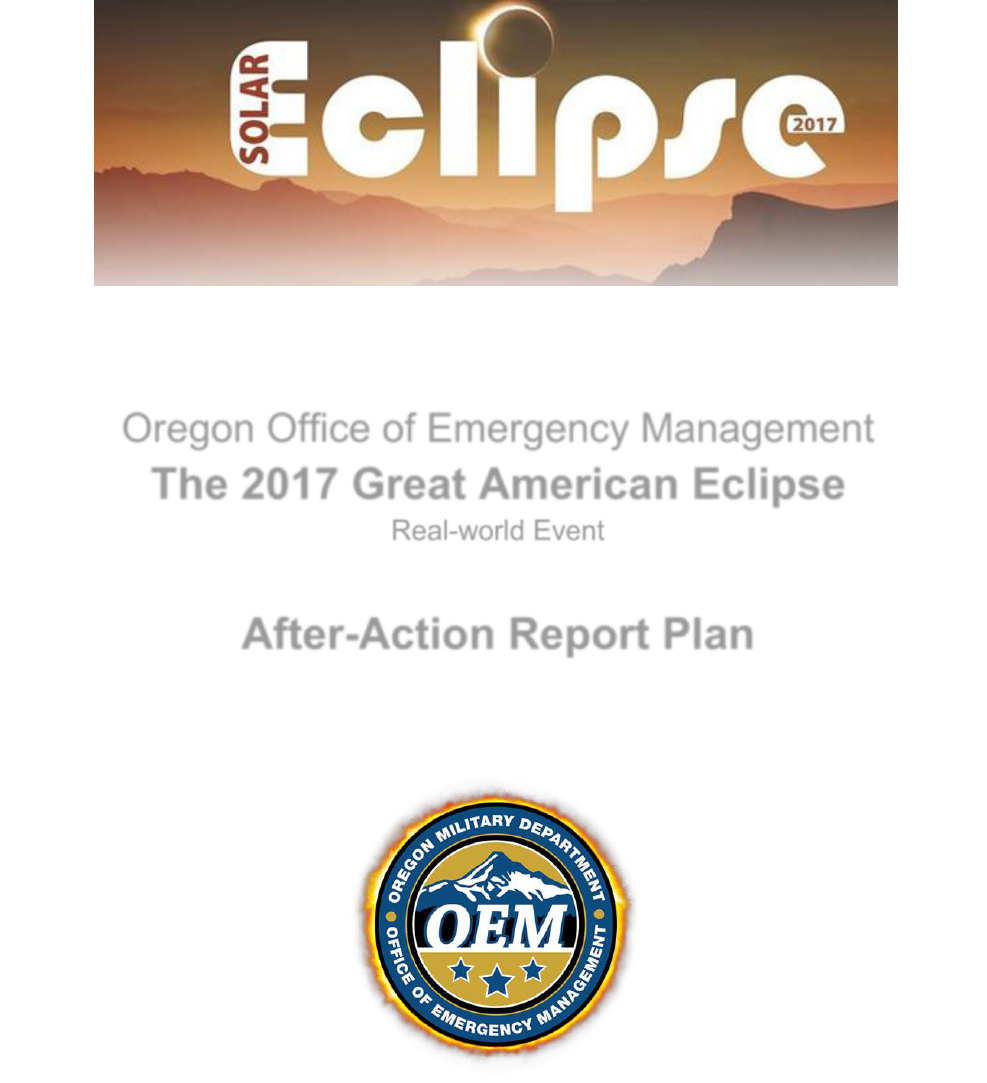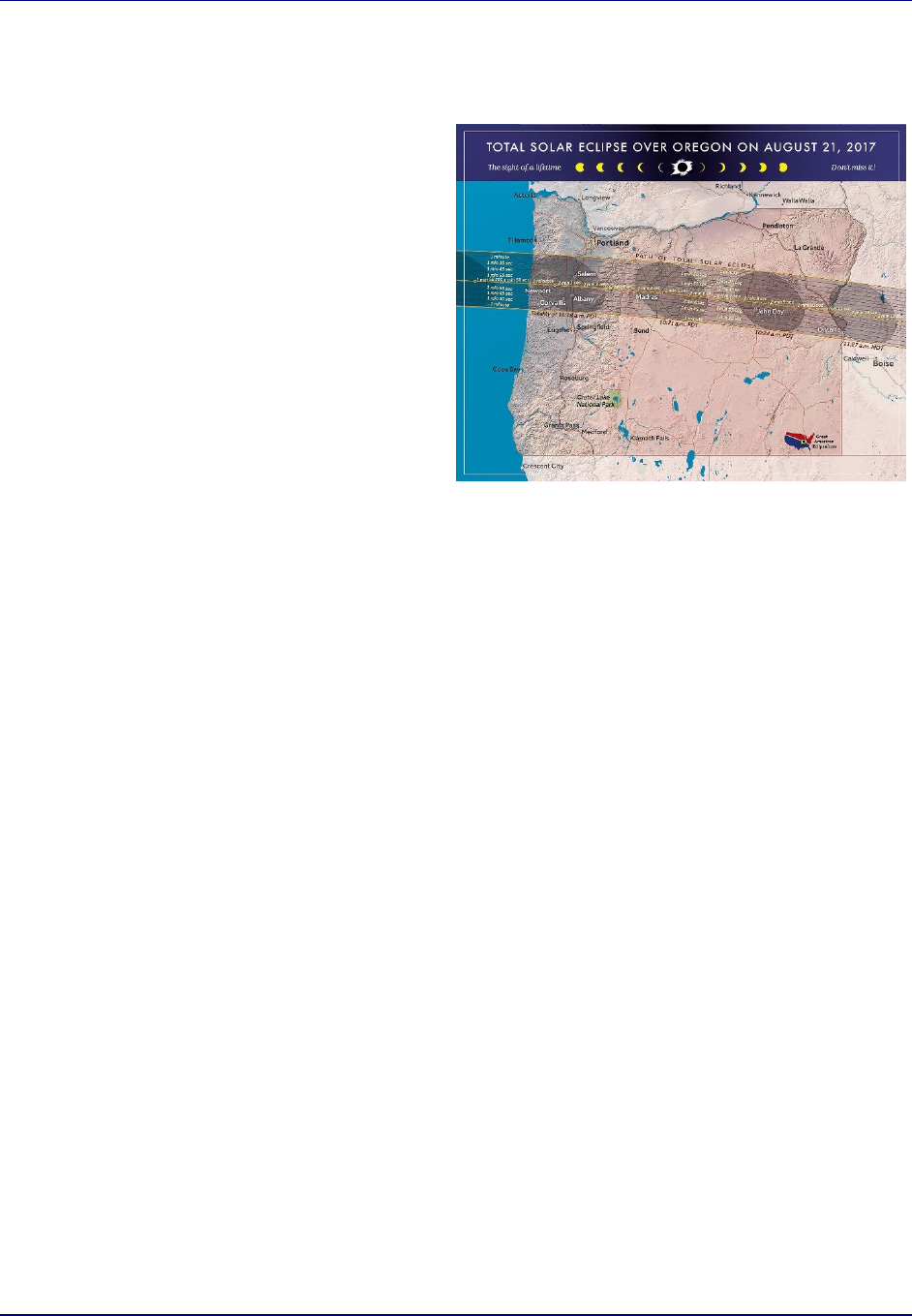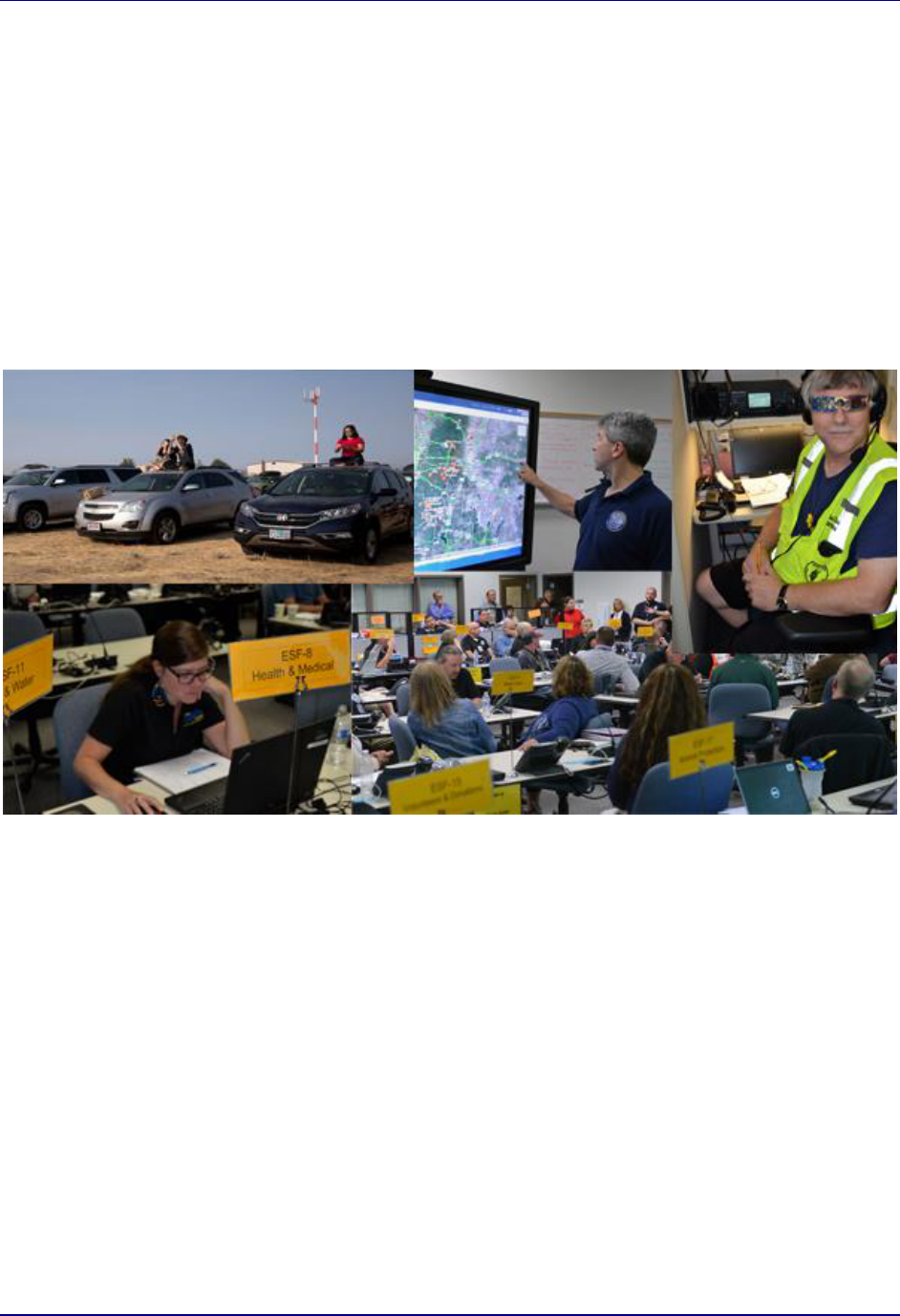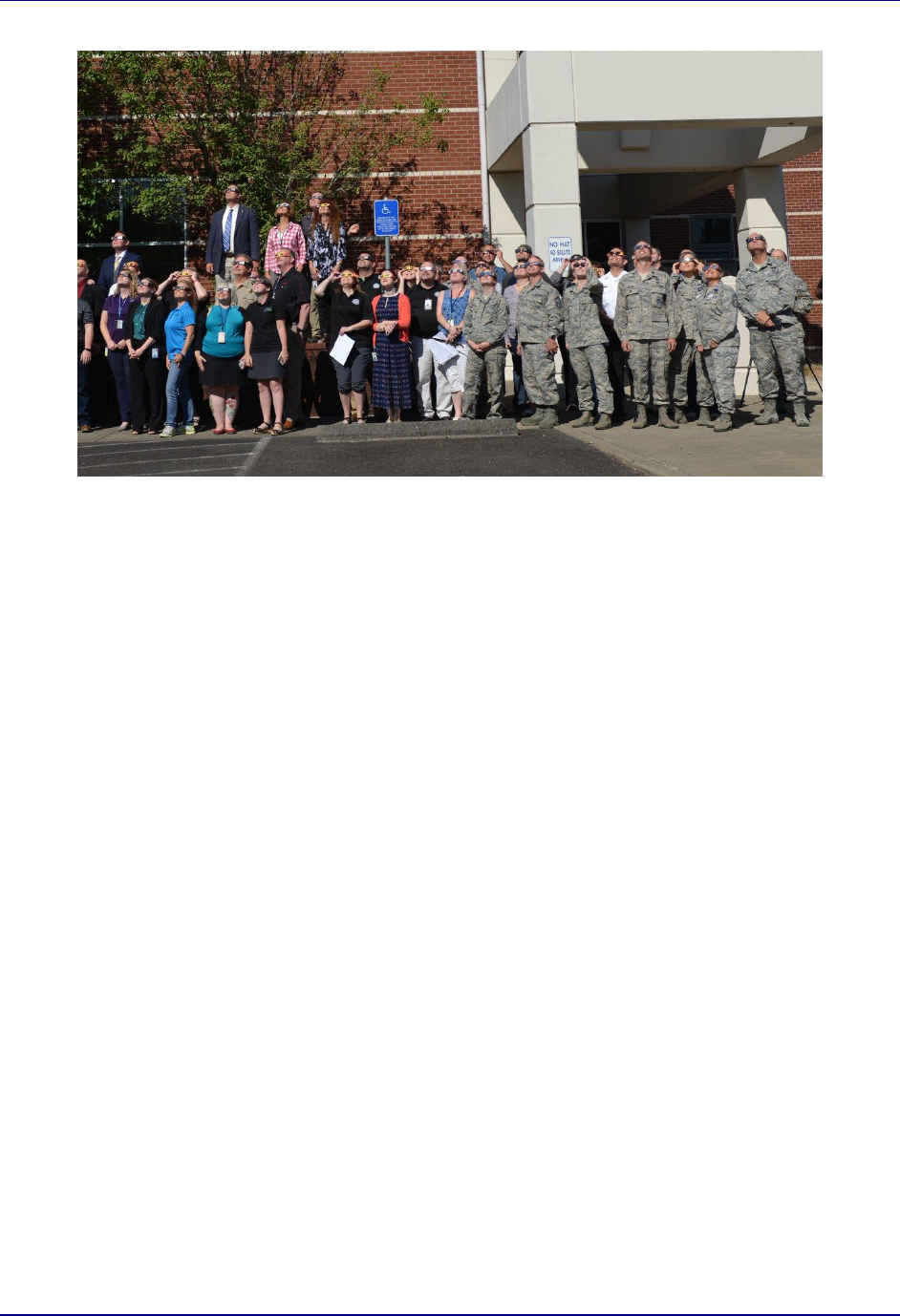
Oregon Office of Emergency Management
The 2017 Great American Eclipse
Real-world Event
August 17 – September 2, 2017
After-Action Report Plan
05/22/2018
This After-Action Report (AAR) is focused solely on the activities of the Oregon Office of Emergency
Management (OEM) and the State Emergency Coordination Center (ECC), in response to the 2017 Great
American Eclipse. Strengths to maintain and areas needing improvement were gathered from OEM’s
ECC team who worked this event, as well as participating Emergency Support Function (ESF) partners
identified at the end of this AAR.

After-Action Report/ The 2017 Great
Improvement Plan (AAR/IP) American Eclipse
Table of Contents ii Oregon Emergency Management
Table of Contents
Executive Summary ............................................................................................iii
Incident Overview .................................................................................................1
Analysis of Core Capabilities ..............................................................................2
Table 1. Summary of Core Capability Performance .............................................................................. 2
Core Capability: Planning ............................................................................. 3
Strengths ............................................................................................................................................... 3
Areas for Improvement ......................................................................................................................... 3
Core Capability: Mass Care Services .............................................................. 4
Strengths ............................................................................................................................................... 4
Core Capability: Public Information and Warning ............................................. 4
Strengths ............................................................................................................................................... 4
Core Capability: Critical Transportation .......................................................... 5
Strengths ............................................................................................................................................... 5
Core Capability: Operational Communications ................................................ 5
Strengths ............................................................................................................................................... 6
Areas for Improvement ......................................................................................................................... 6
Core Capability: Public Health, Healthcare, and Emergency Medical Services ...... 7
Strengths ............................................................................................................................................... 7
Areas for Improvement ......................................................................................................................... 7
Emergency Support Function Actions ...............................................................9
Lead Agency ............................................................................................... 9
Other Support Agencies ............................................................................... 9
Appendix A: Improvement Plan ...................................................................... A1
Appendix B: Incident Participants .................................................................. B1
Acronyms ..............................................................................................................1

After-Action Report/ The 2017 Great
Improvement Plan (AAR/IP) American Eclipse
Executive Summary iii Oregon Emergency Management
EXECUTIVE SUMMARY
The Oregon Office of Emergency Management
(OEM) worked with many state, county, local, and
tribal partners to ensure that the solar eclipse was
enjoyed, safely by all visitors traveling to Oregon
to view the rare event. While in Emergency
Management the goal is to prepare for, prevent and
mitigate disasters, it is also about having plans in
place for major events where large numbers of
people are expected to inundate an area in a short
period of time. For major events, we are
successful when risk is reduced, relationships are
refreshed or developed, and the public understands
how to participate and enjoy the event safely.
Overall Successes:
Conducted a unified special events planning effort between local, tribal and state partners in
preparation for the solar eclipse.
Coordinated joint information system among local, tribal, state and federal partners, providing
effective messaging before, during, and after the event.
Promoted safe observation of the eclipse event.
Coordinated public safety planning (fire service, EMS, law enforcement, public works) and
response among local, state, federal, and tribal stakeholders across Oregon.
Kept the highways safe by developing a responsive highway traffic plan that mitigated the impact
of up to a million additional visitors to Oregon.
Used the eclipse as an opportunity to exercise response capabilities for mass population
displacements.
Successful and sustained activation of local, tribal and state agency operations center and the
State Emergency Coordination Center to facilitate agency response should an emergency occur.
The RAPTOR GIS mapping tool provided exceptional situational awareness for the State ECC
and local jurisdictional EOCs.
General Areas of Improvement:
Special events planning efforts, while coordinated with impacted jurisdictions, did not include
peripheral counties with the potential to be impacted.
A planning assumption of 1 million visitors was utilized, which led to increased expectations of
intensive tourism throughout the state, rather than focusing on the expected effects of a large
number of visitors.
There was a high volume of network Internet users within the State ECC, which caused the
system to slow down, and in some cases it went down, affecting the ability to effectively monitor
the situation across the state.
The existing EMS contract structure does not permit pre-planning or positioning of EMS
resources. It is only designed to respond to an event after it has occurred.
While an effective JIS was established, it was not co-located with the State ECC, nor did the
conference room have all the equipment needed to sustain a long term operation.
The administrative burden of balancing eclipse as well as fire operations during a State ECC
activation exceeded current OEM staffing capabilities.

After-Action Report/ The 2017 Great
Improvement Plan (AAR/IP) American Eclipse
Incident Overview 1 Oregon Emergency Management
INCIDENT OVERVIEW
Incident Name
The 2017 Great American Eclipse
Incident Dates
08/16/2017 – 09/02/2017
Scope
The solar eclipse occurred on Monday, 8/21, beginning at approximately 9:04 am (all
times are PST) and ending at 11:46 am.
Mission Area(s)
Protection and Response
Core Capabilities
Planning
Mass Care Services
Public Information and Warning
Critical Transportation
Public Health, Healthcare, and Emergency Medical Services
Operational Communications
Objectives
1. Conduct a unified special event planning process, including identifying likely
ECC/AOC/EOC activation and staffing.
2. Use the eclipse as an opportunity to plan response capabilities for mass population
displacements.
3. Establish a joint information system among local, state, federal, and tribal
stakeholders, ensuring consistent message distribution and amplification of public
messaging.
4. Coordinate public safety planning (fire service, EMS, law enforcement, public
works) and response among local, state, federal, and tribal stakeholders across
Oregon, including in the areas of resource management, mutual aid assignments,
common staging areas, EOC activity, and declarations of emergency.
5. Keep highways safe by developing a responsive highway traffic plan that mitigates
the impacts of up to a million visitors using traffic management strategies and
equipment, public messaging, incident response crews, and traffic clearance
protocols.
6. Prevent and respond to public health consequences of the eclipse and population
influx.
7. Through multiple redundant methods establish consistent communication among
field response personnel, incident command posts, emergency operations centers,
and public safety answering points in anticipation of severe degradation in cellular
network service and greatly increased usage on radio nets.
8. Promote safe observation of this rare celestial event.
Threat or Hazard
Stresses related to large population movements and gatherings and other social
conditions.
Lead Agency
Oregon Emergency Management
Participating
Organizations
Federal, state, local, tribal, and non-governmental organizations. Complete list of
participating agencies and descriptions in Appendix B.
Point of Contact

After-Action Report/ The 2017 Great
Improvement Plan (AAR/IP) American Eclipse
Analysis of Core Capabilities 2 Oregon Emergency Management
ANALYSIS OF CORE CAPABILITIES
Objective
Core Capability
Performed
without
Challenges
(P)
Performed
with Some
Challenges
(S)
Conduct a unified special event planning process,
including identifying likely ECC/AOC/EOC activation
and staffing.
Planning
X
Use the eclipse as an opportunity to exercise response
capabilities for mass population displacements.
Mass Care
Services
X
Establish a joint information system among local, state,
federal, and tribal stakeholders, ensuring consistent
message distribution and amplification of public
messaging.
Public Information
and Warning
X
Coordinate public safety planning (fire service, EMS, law
enforcement, public works) and response among local,
state, federal, and tribal stakeholders across Oregon,
including in the areas of resource management, mutual
aid assignments, common staging areas, EOC activity,
and declarations of emergency.
Planning
X
Keep highways safe by developing a responsive highway
traffic plan that mitigates the impacts of up to a million
visitors using traffic management strategies and
equipment, public messaging, incident response crews,
and traffic clearance protocols.
Critical
Transportation
X
Prevent and respond to public health consequences of the
eclipse and population influx.
Public Health,
Healthcare, and
Emergency
Medical Services
X
Through multiple redundant methods establish consistent
communication among field response personnel, incident
command posts, emergency operations centers, and
public safety answering points in anticipation of severe
degradation in cellular network service and greatly
increased usage on radio nets.
Operational
Communications
X
Promote safe observation of this rare celestial event.
Public Information
and Warning
X
Ratings Definitions:
Performed without Challenges (P): The targets and critical tasks associated with the core capability were completed in a
manner that achieved the objective(s) and did not negatively impact the performance of other activities. Performance of this
activity did not contribute to additional health and/or safety risks for the public or for emergency workers, and it was conducted
in accordance with applicable plans, policies, procedures, regulations, and laws.
Performed with Some Challenges (S): The targets and critical tasks associated with the core capability were completed in a
manner that achieved the objective(s) and did not negatively impact the performance of other activities. Performance of this
activity did not contribute to additional health and/or safety risks for the public or for emergency workers, and it was conducted
in accordance with applicable plans, policies, procedures, regulations, and laws. However, opportunities to enhance
effectiveness and/or efficiency were identified.
Table 1. Summary of Core Capability Performance
The following sections provide an overview of the performance related to each exercise objective and associated
core capability, highlighting strengths and areas for improvement.

After-Action Report/ The 2017 Great
Improvement Plan (AAR/IP) American Eclipse
Analysis of Core Capabilities 3 Oregon Emergency Management
Core Capability: Planning
Description: Conduct a systematic process engaging the whole community as appropriate in the
development of executable strategic, operational, and/or tactical-level approaches to meet
defined objectives.
Strengths
The partial capability level can be attributed to the following strengths:
Strength 1: OEM conducted a unified special event planning process, including identifying
likely ECC/AOC/EOC activation and staffing.
Strength 2: OEM planning staff and team lead created an Eclipse Special Events plan that was
edited and shared statewide as appropriate.
Strength 3: OEM assisted in coordination of public safety planning (fire service, EMS, law
enforcement, public works) and response among local, state, federal, and tribal stakeholders
across Oregon, including in the areas of resource management, mutual aid assignments, common
staging areas, EOC activity, and declarations of emergency.
Strength 4: Great American Eclipse coordination calls were held monthly starting in April 2017,
and increased to weekly beginning in June 2017. Pre-event briefings occurred at regular intervals
leading up to the eclipse.
Strength 5: The prepositioning of National Guard aviation and personnel assets allowed for a
quicker response to an emergency requiring their assistance. National Guard personnel assisted
local jurisdictions in traffic control.
Areas for Improvement
The following areas require improvement to achieve the full capability level:
Area for Improvement 1: OEM lacks the staffing resources to manage evolving partnerships,
multi-jurisdictional planning efforts, and engage with partners that may also be under-resourced
for statewide planning initiatives and corresponding documentation requirements.
Analysis: Continually evolving partnerships, planning direction, and a lack of participation
increased the administrative burden of planned document maintenance beyond available OEM
staffing capabilities.
Area for Improvement 2: The eclipse planning coordination calls were only open to the core
eclipse planning team. The eclipse planning coordination call meeting summaries were
distributed to only those jurisdictions that were part of the eclipse core planning team.
Analysis: Invited participants of eclipse initial planning calls were those jurisdictions in the core
planning team. Six months pre-event, the planning calls were opened to all jurisdictions.

After-Action Report/ The 2017 Great
Improvement Plan (AAR/IP) American Eclipse
Analysis of Core Capabilities 4 Oregon Emergency Management
Analysis: Meeting summaries were distributed to only those invited participants of eclipse
planning calls. Draft copies of the eclipse plan were distributed to all jurisdictions.
Area for Improvement 3: JIC/JIS participants and staff needed one location in which to share
pertinent documents for planning purposes.
Analysis: During the planning process there was no state approved platform.
Area for Improvement 4: A planning assumption was created for a specific number of visitors.
Analysis: Visitor population estimates were established to provide a basis for preparedness,
prevention, protection, response, and recovery planning and not to attempt to forecast actual
visitors. There is a need to develop a stronger, more focused scenario planning process. In
addition, there is a need for clearer messaging as to why we make planning assumptions.
Area for Improvement 5: ESF Partner roles and responsibilities are not well defined outside of
the initial brief that each agency receives upon being welcomed to the OERS Council.
Analysis: ESF Partner Roles and Responsibilities are defined and supported within the State
Emergency Operations Plan (EOP), ESF one pagers, and State ECC ESF specific folders.
Additional efforts are underway to develop Just in Time Training to add specificity and
clarification to the ESF Partner Roles and Responsibilities.
Core Capability: Mass Care Services
Description: Provide life-sustaining and human services to the affected population, to include
hydration, feeding, sheltering, temporary housing, evacuee support, reunification, and
distribution of emergency supplies.
Strengths
The full capability level can be attributed to the following strengths:
Strength 1: The eclipse was used as an opportunity to exercise response capabilities for mass
population displacements.
Core Capability: Public Information and Warning
Description: Deliver coordinated, prompt, reliable, and actionable information to the whole
community through the use of clear, consistent, accessible, and culturally and linguistically
appropriate methods to effectively relay information regarding any threat or hazard, as well as
the actions being taken and the assistance being made available, as appropriate.
Strengths
The full capability level can be attributed to the following strengths:

After-Action Report/ The 2017 Great
Improvement Plan (AAR/IP) American Eclipse
Analysis of Core Capabilities 5 Oregon Emergency Management
Strength 1: The eclipse planning team established a Joint Information System (JIS) among
local, state, federal, and tribal stakeholders, ensuring consistent message distribution and
amplification of public messaging.
Strength 2: The JIS met over a period of six months and was integral in planning and
operational efforts; the JIC was activated August 17, 2017. JIS staff appreciated JIS meetings
and found them to be a great opportunity to network/build relationships, collect/distribute talking
points
Strength 3: The JIS and stakeholders developed a consistent set of messages, reporting formats,
and communication protocols to ensure consistent and effective efforts during the eclipse as well
as to promote safe observation of the eclipse event.
Strength 4: The RAPTOR GIS mapping system received 42,879 views from 8/15 – 8/22.
RAPTOR provided exceptional situational awareness for State ECC operations during the
Eclipse event. The JIC was also involved in promoting the application and encouraging other
state/federal/local partners to share it as well.
Strength 5: Public interest in the Great American Eclipse was widespread, and in addition to
having some of the best forecasted viewing, Oregon was the first state in the United States to
experience totality. The OEM PIOs, along with ESF Partner PIOs, provided regular media
talking points and briefings. OEM hosted multiple media interviews.
Core Capability: Critical Transportation
Description: Provide transportation (including infrastructure access and accessible transportation
services) for response priority objectives, including the evacuation of people and animals, and
the delivery of vital response personnel, equipment, and services into the affected areas.
Strengths
The full capability level can be attributed to the following strengths:
Strength 1: The state response demonstrated a proficiency for keeping highways safe by
developing a responsive highway traffic plan that mitigated the impacts of up to a million
visitors using traffic management strategies and equipment, public messaging, incident response
crews, and traffic clearance protocols.
Core Capability: Operational Communications
Description: Ensure the capacity for timely communications in support of security, situational
awareness, and operations by any and all means available, among and between affected
communities in the impact area and all response forces.

After-Action Report/ The 2017 Great
Improvement Plan (AAR/IP) American Eclipse
Analysis of Core Capabilities 6 Oregon Emergency Management
Strengths
The partial capability level can be attributed to the following strengths:
Strength 1: Through multiple redundant methods, the state planning team established consistent
communication among field response personnel, incident command posts, emergency operations
centers, and public safety answering points in anticipation of severe degradation in cellular
network service and greatly increased usage on radio nets.
Strength 2: FEMA pre-staged two MERS vehicles in support of communications efforts: one in
Salem, at the State ECC, and one in Madras, adjacent to the Central Oregon MACC facility.
Strength 3: The Eclipse Event Upload Utility for RAPTOR and OpsCenter allowed partners to
upload their own event information into an online form which provided users with a simple
method to provide critical data related to events across the state. This form concept can also be
utilized for any other major event where a statewide layer of information may be necessary.
Strength 4: Great American Eclipse coordination calls were held monthly starting in April 2017,
and were increased to weekly beginning in June 2017. Pre-event briefings occurred at regular
intervals leading up to the Eclipse.
Strength 5: OEM and ESF partners regularly briefed situational updates to local and tribal
emergency managers and federal partners during the coordination calls as well as during State
ECC activation.
Strength 6: There was excellent daily coordination between ESF Partners, local EOCs, and State
ECC staff for fire and eclipse operations, which continues to improve on mission assignments.
Strength 7: OEM deployed three staff in support of communicational and emergency
management efforts in jurisdictions that were deemed to be most impacted by the eclipse event.
Staff were deployed to Baker, Deschutes and Grant Counties. The liaisons provided regular
informational briefs to the State ECC while deployed, while also supporting local emergency
management staff in those counties.
Areas for Improvement
The following areas require improvement to achieve the full capability level:
Area for Improvement 1: During the State ECC activation, the OEM Internet system ran
extremely slowly. Several times throughout the event, users were unable to connect to the
internet. The State ECC utilizes OpsCenter to monitor jurisdictional needs as well as RAPTOR
for situational assessments, when the internet was slow or went down, these systems were less
effective.
Analysis: During State ECC activation there were a high volume of network users.
Area for Improvement 2: The JIC operated out of a room adjacent to OEM’s State ECC during
the eclipse activation. While this is an improvement from previous spaces, it required extensive
set up including additional phone lines, a printer, electrical equipment and enhanced Internet
“hot spot.”

After-Action Report/ The 2017 Great
Improvement Plan (AAR/IP) American Eclipse
Analysis of Core Capabilities 7 Oregon Emergency Management
Analysis: The JIC was established outside of the State ECC to allow additional staff and
capability to spread out however it was not assessed completely which left it less than fully
equipped. There is a clear need for a permanent, dedicated public information and warning space
adjacent to the state ECC.
Area for Improvement 3: The multi-jurisdictional eclipse planning coordination calls occurred
at 1500 Pacific Time. Once the State ECC activated, the agency situation reports were due to the
Planning Section at 1500 Pacific Time.
Analysis: There is a need for a dedicated body of staff whose only responsibility is to State ECC
operations. The Situation Report was due at 1500 to allow additional info to be provided during
the call or confirm the information that was provided. During event activation the State ECC
established the coordination calls in an effort to promote consistency in calls and also meet
historical Situation Report delivery schedule.
Core Capability: Public Health, Healthcare, and Emergency Medical
Services
Description: Provide lifesaving medical treatment via Emergency Medical Services and related
operations and avoid additional disease and injury by providing targeted public health, medical,
and behavioral health support, and products to all affected populations.
Strengths
The full capability level can be attributed to the following strengths:
Strength 1: Prevented and responded to public health consequences of the eclipse and the
population influx.
Strength 2: Developed a heath focused preparedness plan to ensure consistent and appropriate
service coverage throughout the state.
Strength 3: OHA activated contracts and agreements with ambulance vendors to provide
additional staffed ambulances across the state. This was enhanced with the use of focused health
based funding to ensure resources were available in the many heavily impacted rural areas.
Areas for Improvement
The following areas require improvement to achieve the full capability level:
Area for Improvement 1: The unique nature of the event and the lack of an existing tracking
mechanism combined to make it difficult to assess coverage and availability of aero-medical
resources throughout the state.
Analysis: Private aero-medical service providers are not required to provide detailed resource
tracking information to state agencies.

After-Action Report/ The 2017 Great
Improvement Plan (AAR/IP) American Eclipse
Analysis of Core Capabilities 8 Oregon Emergency Management
Area for Improvement 2: The existing Emergency Medical System (EMS) contract structure
does not permit state-coordinated pre-planning and/or prepositioning of EMS resources. It is
designed only for a response to an event that has already occurred.
Analysis: A process other than the existing EMS contract mechanism must be used in assessing,
planning, and prepositioning EMS resources.

After-Action Report/ The 2017 Great
Improvement Plan (AAR/IP) American Eclipse
Emergency Support Function Actions 9 Oregon Emergency Management
EMERGENCY SUPPORT FUNCTION ACTIONS
Lead Agency
ESF 5 – Information and Planning: Oregon Office of Emergency Management (OEM)
OEM developed a special event plan and coordinated statewide planning for the eclipse.
OEM hosted up to weekly planning conference calls with Federal, State, ESF partners,
local and tribal emergency managers, and non-profit agencies such as the American Red
Cross.
OEM began working with local and tribal partners in July 2016, and conducted state
agency planning meetings since January 2017, establishing a common operating picture
about this event and its consequences.
The 2017 Total Solar Eclipse special event plan collected preparedness and planning
information from local, tribal, state and federal partners, and NGOs, and was used to
develop numerous additional agency- or jurisdiction-specific documents.
OEM operational staff also coordinated with local and tribal emergency managers in
deploying to affected counties to support emergency managers in their Emergency
Operations Center (EOC) operations.
Supported state Joint Information System planning and staffing
Other Support Agencies
ESF 1 – Transportation: Oregon Department of Transportation (ODOT)
The 5 ODOT Regions worked in direct partnership with county and municipal agencies
to establish unified plans for traffic management on the state transportation system in the
days leading up to during and after the eclipse.
ODOT worked with all state and local law enforcement, fire and EMS agencies to ensure
that we were all able to response as quickly and effectively as possible to any situation
that might happen.
Messaging to the public and visitors: ARRIVE EARLY, STAY PUT, LEAVE LATE
Supported state Joint Information System planning and staffing
ESF 2 – Communications: Department of Administrative Services (DAS) and Public Utility
Commission (PUC)
Representatives from DAS, the Oregon Business Development Department, and the PUC
all engaged with telephone network providers to encourage preparation for the event and
provide emergency managers with information about network improvements and
equipment deployment.
OEM facilitated amateur radio capabilities in the case alternative communications
capabilities were needed.

After-Action Report/ The 2017 Great
Improvement Plan (AAR/IP) American Eclipse
Emergency Support Function Actions 10 Oregon Emergency Management
State agencies that managed radio systems (ODOT, Oregon Department of Forestry
(ODF), Office of State Fire Marshal (OSFM)) conducted planning and assigned staff to
prepare for and respond to incidents during the event.
Local and tribal emergency operations centers (EOCs), state agency operations centers
(AOCs), and the State ECC were connected by multiple redundant communications
methods, including amateur radio, satellite phones, and two Federal Emergency
Management Agency (FEMA) communications vehicles deployed to Oregon.
Supported state Joint Information System planning and staffing
ESF 4 – Firefighting: Oregon Department of Forestry (ODF) and Office of State Fire
Marshal (OSFM), Oregon Parks and Recreation Department (OPRD)
Office of the State Fire Marshal (OSFM)
Deputy state fire marshals supported local emergency planning activities, assisted with
inspections of assembly and residential (hotel and motel) occupancies, and positioned in
areas of the state expected to have increased tourism and pre-planned events to assist and
guide local resources during fires and emergency situations.
OSFM worked directly with county fire defense board chiefs (FDBC) to determine
availability of firefighting resources during the solar eclipse and developed a statewide
plan on how to mobilize them should they be needed
The OSFM mailed out over 11,000 solar eclipse glasses to fire service and OSP
personnel working within the path of totality, along with wildfire and solar eclipse safety
and public education materials.
Created and distributed public information flyers/posters containing wildfire safety
information
Supported state Joint Information System planning and staffing
Oregon Department of Forestry (ODF)
Provided for the safety of firefighters, the public and support personnel, as aligned with
our agency’s mission to prevent and respond to wildfires.
Pre-positioned resources, such as helicopter and air tankers, where the greatest threat of
wildfire existed for full support of initial attack in and near the path of totality ensuring
we were prepared to respond to wildfires.
Provided for continuity of operations in normal fire prevention initiatives, initial attack
and large fire support workloads outside the path of totality.
Working with affiliate Keep Oregon Green, created various wildfire safety materials, ads
and messaging
Oregon Parks and Recreation Department (OPRD)
Monitored more than 4,800 campsites within 30 miles of eclipse totality and instituted
campfire bans in central and eastern Oregon from approximately8/16-8/22
Communicated fire safety, traffic safety and health safety messages to campers
Supported state Joint Information System planning and staffing

After-Action Report/ The 2017 Great
Improvement Plan (AAR/IP) American Eclipse
Emergency Support Function Actions 11 Oregon Emergency Management
ESF 6 – Mass Care: Department of Human Services (DHS)
Monitored solar eclipse event activities throughout Oregon
Maintained situational awareness and monitoring for secondary events, such as fires
Supported state Joint Information System planning and staffing
ESF 7 – Logistics: Department of Administrative Services (DAS)
3 DAS procurement staff and managers were on call/on alert from August 14 – 28.
ESF 8 – Health and Medical: Oregon Health Authority (OHA)
Detected emerging concerns in healthcare delivery and public health through enhanced
disease surveillance, monitoring emergency department and EMS patient data, regional
hospital/EMS coordination calls, and automated and direct status reports.
Supported healthcare and public health surge capacity by providing ambulances, SERV-
OR/Medical Reserve Corps volunteers, environmental health inspectors, and disease
monitoring and control staff/assistance, as well as legal/regulatory support and technical
assistance.
Supported state Joint Information System planning and staffing
ESF 9 – Search and Rescue: Office of Emergency Management (OEM)
OEM established relationships and protocols for resource management in the event SAR
was needed.
From Friday, 8/18 to Tuesday, 8/22, the Oregon Department of Aviation (ODA)
partnered with the Oregon Civil Air Patrol (CAP) to conduct aerial reconnaissance of the
70 mile path of the eclipse from the Coast to Eastern Oregon.
Aerial patrol provided:
o Situational awareness of all airports and state highway within the eclipse path
o SIT-REP to OEM with photos
o Identified high populated areas
o Assessed alternate traveled routes for emergency services
ESF 10 – Hazardous Materials: Department of Environmental Quality (DEQ)
Supported local planning efforts to identify and develop options for treatment and
disposal of increased sewage wastes to campers at special event locations to reduce
incidents of dumping or spills to waters of the state and/or public exposure to infectious
materials.
Supported state Joint Information System planning and staffing, county emergency
planning and preparedness, and activated their Agency Emergency Operation Center in
anticipation of increased spills caused by highway incidents or sewage releases.

After-Action Report/ The 2017 Great
Improvement Plan (AAR/IP) American Eclipse
Emergency Support Function Actions 12 Oregon Emergency Management
ESF 11 – Food and Water: Department of Human Services (DHS)
Monitored solar eclipse event activities throughout Oregon
Maintained situational awareness and monitoring for secondary events, such as fires
Supported state Joint Information System planning and staffing
ESF 12 – Energy: Oregon Department of Energy (ODOE)
Verified the staging of energy resources throughout service territories to minimize
response times in the event of emergencies or major outages.
Confirmed energy utilities had the capacity to provide service if there are additional
demands on their systems with the influx of visitors.
Worked with the petroleum industry and emergency responders and managers to prepare
for the increased demand on fuel supplies.
The petroleum suppliers increased deliveries to gas stations to ensure available fuel
supplies, and continued that strategy through the days following the eclipse. Many
emergency response agencies also increased the amount of fuel supplies on hand, and
contacted the Oregon Department of Energy should they need to arrange for additional
fuel deliveries to support emergency services.
Supported state Joint Information System planning and staffing
ESF 13 – Military Support: Oregon Military Department (OMD)
Oregon National Guard (ORNG) deployed soldiers and airmen in support of 6 different
counties, Baker, Grant, Clackamas, Jefferson, Lincoln and Marion). They assisted the
counties with traffic assistance in various locations as determined by the county EOCs.
Prepositioned multiple aircraft throughout the state to ensure efficient and effective
response to resource transport, medical services, or SAR operations.
Supported state Joint Information System planning and staffing
ESF 14 – Public Information: Oregon Emergency Management (OEM)
Beginning in March, 2017, coordinated a Joint Information System with partner agencies
in the state, counties, tribes and municipalities in the path of totality to ensure consistent
and unified messaging to residents and visitors.
Compiled, collected and distributed talking points as they pertained to public safety,
security, disaster preparedness, disaster response and tourism.
Conducted Joint Information Center training with partner agencies in preparation for the
eclipse
Activated a state Joint Information Center beginning Thursday, 8/17, through Tuesday,
8/22, in which JIC staff monitored social media, responded to media inquiries, provided
public information messaging regarding all aspects of eclipse planning (e.g.,
transportation, health, wildfire safety, etc.)

After-Action Report/ The 2017 Great
Improvement Plan (AAR/IP) American Eclipse
Emergency Support Function Actions 13 Oregon Emergency Management
Through the state JIC, coordinated messaging and communications with three other
regional JICs (coast, valley, central/eastern Oregon)
Coordinated a social media campaign with state agency partners to share key messages
Coordinated a 2-1-1 eclipse call center to handle eclipse related inquiries
ESF 16 – Law Enforcement: Oregon State Police (OSP)
Department of Corrections (DOC)
Prepared for impacts to the roads due to increased traffic. Planned for transport to
facilities, releases and trips.
Institutions developed and reviewed plans for limited visibility, control of inmate
movement, and accountability.
OSP deployed all staff throughout the state to ensure the highest level of service
available.
Department of Public Safety Standards and Training (DPSST)
DPSST provided logistical support to OEM and ODF for the eclipse and were ready to
assist with other requests as needed.
Supported federal partners lodging and support needs in the Salem area.
Supported state Joint Information System planning and staffing
ESF 18 – Business and Industry
Monitored solar eclipse event activities
Maintained situational awareness and monitor for secondary events
Supported state Joint Information System planning and staffing

After-Action Report/ The 2017 Great
Improvement Plan (AAR/IP) American Eclipse
Emergency Support Function Actions 14 Oregon Emergency Management

After-Action Report/ 2017 Great
Improvement Plan (AAR/IP) American Eclipse
Appendix A: Improvement Plan A1 Oregon Emergency Management
DRAFT APPENDIX A: IMPROVEMENT PLAN
This IP has been developed specifically for Oregon Emergency Management as a result of The 2017 Great American Eclipse from 08/16/2017 – 09/02/2017.
Issue
Core Capability
Recommendation
POETE Element
Responsible ESF
Timeframe
1: Administration of
special events planning
Planning
Increase staffing to manage the administrative burden of a
State ECC activation and event planning. This should include
stand-alone staffing for regional liaisons, tribal liaison,
incident management coordinators and staff with specific State
ECC management roles. Continue to evolve special event
planning program to maintain consistency and incorporate
lessons learned. Incorporate the existing OEM special events
tactical plan previously developed with updated materials.
Integrate the special events plan with the JIC communications
plan at the beginning of the planning process.
Identify milestones for document progress with dates to mark
the special events plan FINAL prior to the event occurring.
Planning
ESF 5/OEM
Q 4, 2018
Ongoing
Ongoing
2: Scope of the eclipse
planning calls
Open the coordination calls to interested local, tribal, federal,
and ESF partners interested in the special events planning
process and distribute coordination call meeting summaries to
local and tribal emergency managers, federal, and ESF
partners.
Planning
ESF 5/OEM
Q 4, 2018
3: JIS planning
documentation
OEM to work with IT in supplying one location to share
documents during emergency planning and operations.
Planning
ESF 5/OEM
Q 4, 2018
4: Visitor population
estimates
Create a clearer planning assumption in order to avoid
implying a false sense of accuracy and creating an interest in
the process by which that number was determined, rather than
the expected effects of the visitors.
Planning
ESF 5/OEM
Ongoing
5: ESF Roles and
Responsibilities
Continue to enhance State ECC training materials and
guidance while also developing Just-In-Time training
solutions. Incorporate ESF roles and responsibilities training
during exercises and other non-emergency events and add
specificity and clarification to the ESF Partner Roles and
Responsibilities.
Planning
ESF 5/OEM
Ongoing

After-Action Report/ 2017 Great
Improvement Plan (AAR/IP) American Eclipse
Appendix A: Improvement Plan A2 Oregon Emergency Management
Issue
Core Capability
Recommendation
POETE Element
Responsible ESF
Timeframe
1: OEM Internet
system
Operational
Communications
Assess capabilities and need to work with OEM
Information Technology (IT) to enhance capabilities
and to increase user capacity.
Review and potentially stagger the State ECC/multi-
jurisdictional coordination calls and Situation Report
due times to accommodate those agencies that are
participating in the calls but also need to complete a
Situation Report.
Organizing
Equipping
Organizing
ESF 5/OEM
Q 4, 2018
Q 1, 2019
Q 1, 2019
2: JIC activation
space
There is a clear need for a permanent, dedicated public
information and warning space adjacent to the State
ECC.
Equipping
ESF 5/OEM
Q 1, 2019
3: Eclipse planning
team coordination and
deliverables
There is a need for a dedicated body of staff whose
only responsibility is to State ECC operations to
coordinate required planning communications and
deliverables.
Equipping
ESF 5/OEM
Q 1, 2019
1: Aero medical
resource availability
Public Health,
Healthcare, and
Emergency
Medical Services
Establish a tracking mechanism to assess coverage and
availability of aero-medical resources throughout the
state.
Planning
ESF 8
Q 4, 2018
2: EMS contract
structure
Review and make the applicable changes to the current
Emergency Medical System (EMS) contract structure
to allow for pre planning and/or prepositioning of EMS
resources.
Planning
ESF 8
Q 4, 2018

After-Action Report/ The 2017 Great
Improvement Plan (AAR/IP) American Eclipse
Appendix B B1 Oregon Emergency Management
APPENDIX B: INCIDENT PARTICIPANTS
Participating Organizations
Federal
Federal Emergency Management Association
U.S. Army Corps of Engineers
U.S. Bureau of Land Management
U.S. Coast Guard
U.S. Department of Homeland Security
U.S. Forest Service
State
Oregon Department of Administrative Services
Oregon Department of Agriculture
Oregon Department of Aviation
Oregon Department of Corrections
Oregon Department of Energy
Oregon Department of Environmental Quality
Oregon Department of Geology and Mineral Industries
Oregon Department of Human Services
Oregon Department of Justice
Oregon Department of State Police
Oregon Department of Transportation
Oregon Governor’s Office
Oregon Health Authority
Oregon Military Department
Oregon Office of Emergency Management
Oregon Office of the State Fire Marshal
Oregon Parks and Recreation Department
Oregon State Department of Forestry
Oregon State Marine Board
Oregon Tourism Commission
Oregon Travel Experience
Travel Oregon
Counties
Baker
Benton
Clackamas
Crook
Deschutes
Grant

After-Action Report/ The 2017 Great
Improvement Plan (AAR/IP) American Eclipse
Appendix B B2 Oregon Emergency Management
Harney
Jefferson
Lincoln
Linn
Malheur
Marion
Multnomah
Polk
Tillamook
Union
Wheeler
Yamhill
Tribal Nations
Burns-Paiute Reservation
Confederated Tribes Coos Lower Umpqua Siuslaw Indians
Confederated Tribes of Grande Ronde
Confederated Tribes of Siletz Indians
Confederated Tribes of the Umatilla Indian Reservation
Confederated Tribes of Warm Springs
Coquille Indian Tribe
Cow Creek Band of Umpqua Tribe of Indians
Klamath Tribes
Non-governmental Organizations
2-1-1 Oregon
American Red Cross (ARC)
Civil Air Patrol (CAP)
Oregon Association of Counties
Oregon Titan Fusion Center
Oregon Volunteers Active in Disaster (ORVOAD)
SAIF

After-Action Report/ The 2017 Great
Improvement Plan (AAR/IP) American Eclipse
Acronyms 1 Oregon Emergency Management
ACRONYMS
AAR After Action Report
ARC American Red Cross
CAP Civil Air Patrol
DEQ Department of Environmental Quality
DOC Department of Corrections
DHS Department of Human Services
DPSST Department of Public Safety Standards and Training
ECC Emergency Coordination Center
EOC Emergency Operations Center
ESF Emergency Support Function
FDBC Fire Defense Board Chief
FEMA Federal Emergency Management Agency
GIS Geographic Information System
IT Information Technology
JIC Joint Information Center
JIS Joint Information System
MACC Multi Agency Coordination Center
MERS Mobile Emergency Response System
ODA Oregon Department of Agriculture
ODA Oregon Department of Aviation
ODF Oregon Department of Forestry
ODOT Oregon Department of Transportation
OEM Oregon Emergency Management
OERS Oregon Emergency Response System
OHA Oregon Health Authority
OMD Oregon Military Department
ORNG Oregon National Guard
ORVOAD Oregon Voluntary Organizations Active in Disasters
OSFM Office of State Fire Marshal
OSP Oregon State Police
PIO Public Information Officer
PUC Public Utility Commission
RAPTOR Real-time Assessment and Planning Tool for Oregon
